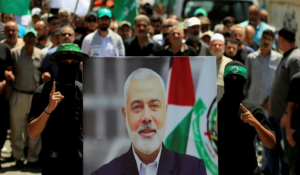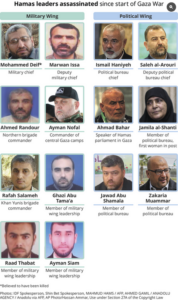Haniyeh’s death is a blow to Hamas but history proves there’s always a replacement

Hamas members hold a poster of Hamas political chief Ismail Haniyeh during a protest to condemn his killing, at al-Bass Palestinian refugee camp, in the southern port city of Tyre, Lebanon, 31 July 2024
Jack Khoury writes in Haaretz on 31 July 2024:
Israel’s assassination of Hamas’ political leader Ismail Haniyeh is a blow to one of the group’s greatest symbols and sends a message that all its leaders are now on Israel’s target list, regardless of their location.
The fact that Haniyeh was killed while visiting Tehran, where he was welcomed as a guest of the state and Iran’s Revolutionary Guards, also sends a provocative message to the group and the Islamic Republic. Haniyeh’s assassination creates a vacuum in Hamas leadership, but not one too significant to fill quickly.
It is well known that most of the Palestinian resistance organizations, particularly the Islamic ones, have been dealing with the threat of Israel’s targeted killings for many years. This is especially true for Hamas, whose leaders have been targeted for many long years, including the group’s founder Sheikh Ahmed Yassin and other senior figures like Abdel Aziz Rantisi, as well as the group’s military wing leaders such as “The Engineer” Yahya Ayyash and Ahmed Said Jabari, and many others.
To some extent, the assassination of Haniyeh that occurred overnight into Wednesday mirrors one of the previous Israeli targeted killings – that of Saleh al-Arouri, Haniyeh’s deputy. Al-Arouri was killed in Hezbollah’s stronghold in Beirut, while Haniyeh, the head of the pyramid, was taken out while in Tehran.
Like al-Arouri, Haniyeh’s death is not an “organizational earthquake” as far as Hamas is concerned. Two members of the group’s political bureau senior members, Khaled Meshal and Mousa Abu Marzouk, can immediately fill the position, as can Khalil al-Hayya, who leading the negotiations in Cairo and Doha, and has recently also met with Hezbollah leader Hassan Nasrallah.

Hamas leaders assassinated since Gaza war start
Al-Hayya is Sinwar’s deputy and has become a highly dominant figure since the war began. Abu Marzouk, on the other hand, handles the internal Palestinian while also working with the group’s contact with China and Moscow.
Hamas leadership will need to decide whether to immediately appoint a new head of its political bureau or an acting one. The convening of the group’s political bureau will be difficult, especially given the scope of destruction in Gaza and the fact that Hamas members are considered targets for further assassinations.
While Haniyeh climbed the ranks of Hamas’ leadership and worked closely with the group’s founder Sheikh Ahmed Yassin, he was never considered a strategist, a senior commander, or one of the group’s leading figures. In practice, Hamas was focused on its activities in Gaza, especially after the takeover of the Strip in 2007. Until then, Hamas was more concentrated in its activities abroad, led by Khaled Meshal, who also survived a failed assassination attempt by the Israeli Mossad in Amman.
Since 2007, Hamas’ main concerns shifted to the Gaza Strip, where the group has accumulated significant power. In 2017, Haniyeh was elected head of Hamas’ political bureau and moved to Qatar, thus succeeding Khaled Mashaal, who had served in the position for nearly two decades. One of the reasons for his departure from Gaza was his conflict with the military commander of Hamas in the Gaza Strip.
This resulted in a leadership split between the two powerful figures operating from two camps – Haniyeh and senior political wing officials outside the Strip, and Sinwar and military wing members in the tunnels across the Strip. In Gaza and the Palestinian public opinion, real power remained with the group’s Gaza-based military leaders, Yahya Sinwar and Mohammed Deif.
Only in Gaza Hamas has a well-developed military force, while in the West Bank, it has no official organization due to pressure from Israel and the Palestinian Authority. Most of Hamas’ activity in the West Bank is carried out by terror cells in the refugee camps and cities like Jenin and Nablus, where many group members have been targeted by Israel along with Islamic Jihad and Fatah-affiliated resistance organizations’ members. Hamas has a military presence in Lebanon, which operates under Hezbollah’s protection.
For Hamas, the damage to its infrastructure in Gaza, alongside the assassination of figures like Deif and Marwan Issa, is seen as a much more significant blow. Past assassinations, however, have shown that every one of the group’s killed leaders had a replacement and that the group’s control on the ground is not dependent upon one figure or another.
Yahya Sinwar was in prison when Hamas leadership decided to take over the Gaza Strip in a coup. Upon his release, he quickly managed to find his way into the group’s leadership in Gaza, and he is its most influential figure until today.
This article is reproduced in its entirety
